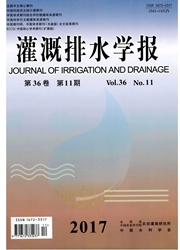

 中文摘要:
中文摘要:
为了改善坡面水系分段拦蓄径流泥沙的调控效益,采用室内人工模拟降雨试验,探讨l坡面集中汇流(T1)和“燕型”分流(T2)2种不同的控制排水措施下的坡面产沙产流过程。结果表明,与无措施坡面(CK)对比,2种不同排水布置方式均能显著延长径流急剧增加的历时,降低产流率增速,减少产流深46.61%~56.40%,使产流率与径流历时的对数拟合系数均达到0.85以上,且T2处理坡面产流率较T1处理变化更平稳,产流率和产流总量在各坡度均表现为T2处理T2处理,在15°坡面则相反。而坡面径流含沙量与坡面累计产沙量变化并没有显著的对应关系;T1处理有利于削弱坡度对侵蚀量的影响,而T2处理对减少产流受坡度因子影响的效果更显著。
 英文摘要:
英文摘要:
In order to improve the intercepted regulation effects of slope drainage on the runoff and sediment in the sloping arable land, with the slope without any drainage system (CK) as the control, artificial rainfall simulation experiment was conducted to study the different characteristics of runoff and sediment under two different slope drainage layout measures which were designed to lead water flow in concentration (T1) and shunt in a form of "swallow" (T2), respectively. The results showed that T1 and T2 treatments could significantly extend the duration of runoff dramatic increase by reducing its growth rate and the depth of runoff by 46.61%-56.40%, and adjusted the runoff rate to a logarithmic fitting relationship with the runoff duration and the coefficients was above 0.85 compared to CK, while slope runoff rate under T2 treatment changed more smoothly than T1 treatment. The discharge order of runoff rate and its total amount were shown as T2〈T1 〈CK. Besides, the regulation effect on runoff sediment carrying ability was different between the slopes with different gradients under different drainage layout measures. It was shown as a sequence of T1 treatment 〉T2 treatment on the slope of 5° and 10° , but presented an opposite trend on 15° slope. There were no significant corresponding changes relationship between the sediment content and cumulative sediment yield. Thus, T1 treatment was more beneficial to weaken the impact of slope gradient on erosion, while T2 treatment significantly contributed more to reducing the influence of gradient factor on slope runoff.
 同期刊论文项目
同期刊论文项目
 同项目期刊论文
同项目期刊论文
 期刊信息
期刊信息
